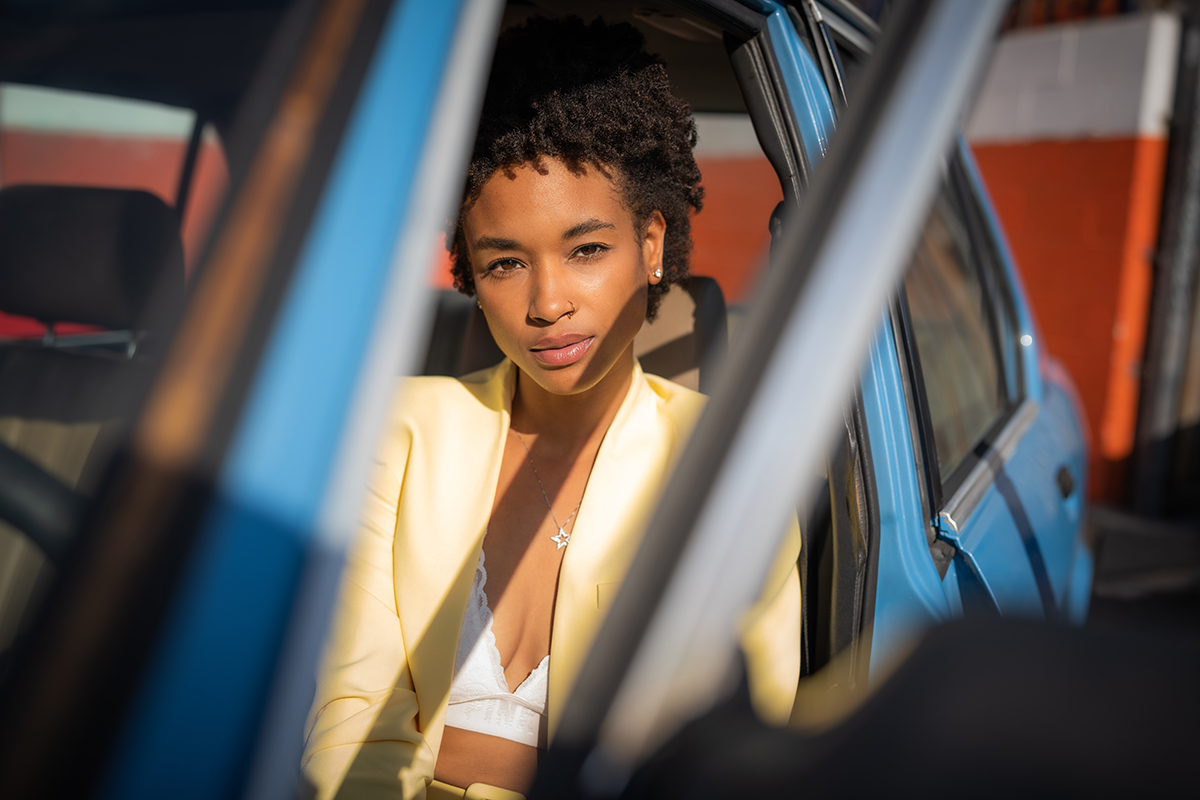Primed for a Fashion Shoot
Paul Winner’s Tamron SP 35mm F/1.4 lens helps him get creative in Compton.
Share the article:
More Photo Tips | Video Gallery | Photo Gallery | Enewsletter sign-up
By Jenn Gidman
Images by Paul Winner
Paul Winner has explored Great Sand Dunes National Park, profiled a mixed-media artist, and ventured into the Amazonian rainforest for an ayahuasca retreat, all with a lineup of Tamron lenses that offer him the reliability, versatility, and image quality he requires. Now, the LA- and NY-based photographer is putting his newest Tamron acquisition—the SP 35mm F/1.4 Di USD prime lens—through its paces, most recently on an editorial-style fashion shoot in the LA area.
“The model I worked with, Tyler Faye, recommended this spot, an urban flea market in Compton,” Paul says. “It was a very loose, free-flowing shoot, in the parking lot with all of these BMWs. Tyler is a professional who gets hired by multiple modeling agencies, and whom I’ve worked with before, and she’s incredible to collaborate with—she knows all of her angles and is immediately on as soon as she arrives to a session. Between her acumen and the color palette of those cars, everything came together. I let the environment guide me on the content we created.”
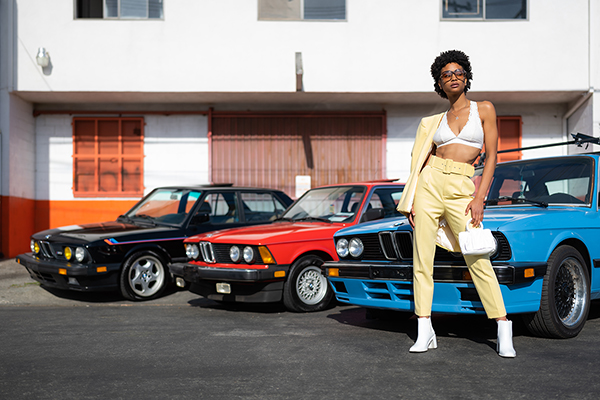
35mm, F/1.6, 1/2500 sec., ISO 30
Click image to view larger
Paul chose to shoot with the 35mm prime for several reasons. “This lens provides a relatively wide field of view without any sort of distortion, which lends itself well to working with models,” he says. “I’m also able to shoot in spaces where I can capture a sense of the environment without the image being too wide or too tight. Plus, the shallow depth-of-field offered by that F/1.4 maximum aperture allows me to beautifully separate my subject, who remains super-sharp, from the environment. I always end up with a high-end result.”
Keeping the creative juices flowing on the lot required a bit of ingenuity—helped along by Tyler’s professional abilities. “We shot this in a matter of 45 minutes,” Paul says. “My goal was to create more depth and interaction within the environment we were working in. With someone as talented as she is, with that much experience under her belt, I knew I’d be able to pull out a number of different moods during this shoot. And she was a total pro. She has a natural way of moving and of creating a flow that offers me plenty of variety.”
Paul’s job as the photographer was to move through that same space and create an equally dynamic story. “I wanted people to look at these photos and not just think, ‘Wow, here’s an attractive person standing in the middle of the street,’” he says. “I hoped to produce a story that made them ask: ‘Why are we here? What’s really going on in this picture?’”
The image quality produced by the 35mm F/1.4 lens—enhanced by its BBAR-G2 coating to reduce ghosting and flare—is just one of the reasons why it proved the ideal lens for Paul’s shoot. “First of all, the autofocus is really fast, and the images I get with this lens are sharp,” he says. “Color rendition, especially when it comes to skin tones, is also important to me, and this lens delivers.”
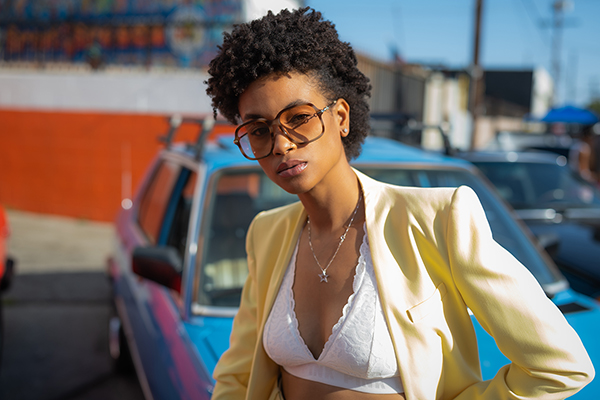
35mm, F/2, 1/640 sec., ISO 30
Click image to view larger
Paul photographed Tyler in the golden light of late afternoon, around 4pm. “With lighter-skinned models, you sometimes have to worry about them blowing out in harsher lighting conditions or getting lost in the environment,” he says. “With darker-skinned models like Tyler, while you definitely see wider latitude in that regard, you have to be cognizant of the sculpting that can occur from the light. For instance, you might get light bouncing off a windshield and producing a highlight around her neck. Once I worked around all of those things, I was very happy with how the 35mm rendered the images.”
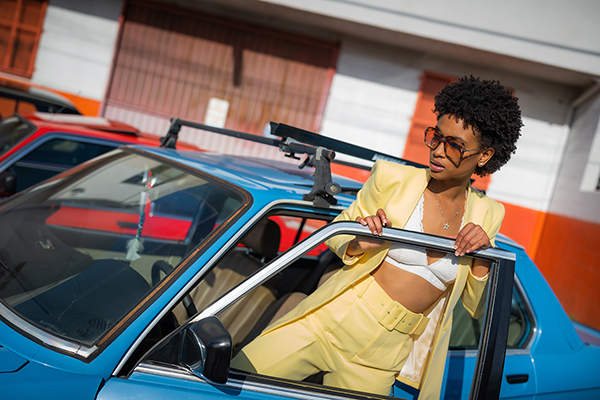
35mm, F/2.2, 1/1250 sec., ISO 30
Click image to view larger
Although some might feel that using a prime lens for a shoot like this may pose certain limitations that could hamper creativity, Paul emphasizes that’s not the case. “In fact, one of the things I tell people when I’m encouraging them to work on their craft is to pick a prime lens like the 35mm and make what they’re trying to accomplish happen with just that one lens,” he says. “Working that way trains you to see what that lens can do, and it makes you a better photographer. You become more skilled at cleaning up your frame, checking your corners, figuring out when to move closer and when to step back. You start to realize when you can fit in a space and get a scene to work well.”
Plus, the 35mm’s F/1.4 maximum aperture and ability to produce bokeh, defocus blur—both in front of and behind the plane of focus, and without any chromatic aberration that appears as color fringe—offered Paul even more creative options on his makeshift “set.”
“I loved experimenting with that aspect of the lens,” he says. “In one instance, I played around with it to soften the lines of the car door that were framing Tyler as she sat in one of the BMWs. In another, it allowed me to keep the focus squarely on her as she was leaning through a car window. The dreamcatcher dangling from the rearview mirror was an interesting detail, but I was able to blur it out so it didn’t detract from my subject. Or sometimes you want to create a closer feeling, a sense that your model is deep in the scene, but you don’t need to show the viewer that the door is scuffed or there are fingerprints on the window. Everything I don’t want to be in focus falls off so nicely with this lens.”
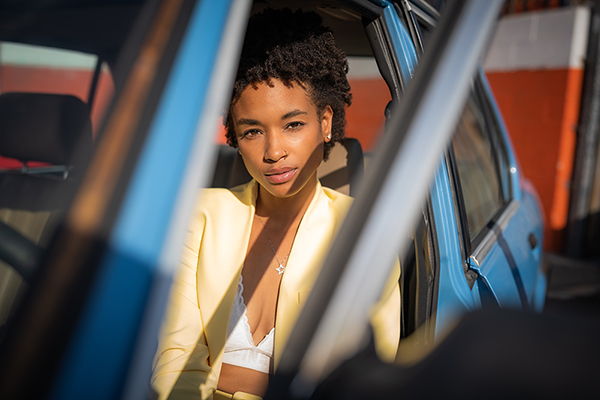
35mm, F/2.2, 1/1000 sec., ISO 30
Click image to view larger
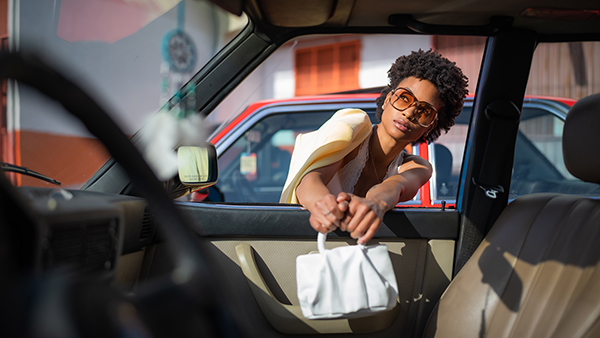
35mm, F/1.6, 1/1600 sec., ISO 30
Click image to view larger
More Photo Tips | Watch Videos | Learn More About Tamron Lenses | Photo Gallery
